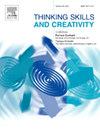伪创造力和真创造力在概念界限上有所不同
IF 4.5
2区 教育学
Q1 Social Sciences
引用次数: 0
摘要
创造力既需要原创性,也需要有效性。没有效果的创意意味着伪创意,通常是由于创意评估的缺陷。关于伪创造力和真实创造力背后的过程的研究是有限的。本研究利用联想思维任务对具有伪创意倾向的个体进行识别,并将其与具有真正创意倾向的个体进行比较,重点关注记忆搜索和语义记忆表征。在实验1中,适度分析基于多重创造力测量将被试分为三组:真实创造力、伪创造力和低创造力(对照组)。这些小组完成了涉及动物概念搜索的目标导向联想任务。结果表明,伪创造力与减少聚类和聚类切换以及更频繁的硬切换有关。实验2采用自由联想的方法构建了三组的语义网络,结果表明伪创意组呈现出非结构化、超连接的语义网络。这些发现首次描述了伪创造力背后的认知过程。他们发现,早在创意产生阶段,伪创意就表现出更宽松的概念界限,并与真正的创意表现出差异。这为创造性需要词汇结构的灵活性和刚性之间的平衡这一理论提供了一个直接的调查。本文章由计算机程序翻译,如有差异,请以英文原文为准。
Pseudo-creativity and authentic creativity differ in conceptual boundaries
Creativity requires both originality and effectiveness. Originality without effectiveness indicates pseudo-creativity, often due to deficits in idea evaluation. Research on the processes underlying pseudo-creativity and authentic creativity is limited. This study operationally identified individuals with pseudo-creative tendencies and compared them with authentically creative individuals using associative thinking tasks related to idea generation, focusing on memory search and semantic memory representations. In Experiment 1, moderation analysis classified participants into three groups based on multiple creativity measurements: authentic creativity, pseudo-creativity, and low creativity (control). These groups completed a goal-directed association task involving animal concept searching. Results showed that pseudo-creativity was associated with reduced clustering and cluster switching, along with more frequent hard switching. Experiment 2 constructed semantic networks for the three groups using free association, revealing that pseudo-creativity group exhibited a de-structured and hyperconnective semantic network. These findings provide the first characterization of the cognitive processes underlying pseudo-creativity. They reveal that pseudo-creativity exhibits looser conceptual boundaries and demonstrates differences from authentic creativity as early as the idea-generation phase. This offers a direct investigation for the theory that creativity requires a balance between the flexibility and rigidity of lexicon structure.
求助全文
通过发布文献求助,成功后即可免费获取论文全文。
去求助
来源期刊

Thinking Skills and Creativity
EDUCATION & EDUCATIONAL RESEARCH-
CiteScore
6.40
自引率
16.20%
发文量
172
审稿时长
76 days
期刊介绍:
Thinking Skills and Creativity is a new journal providing a peer-reviewed forum for communication and debate for the community of researchers interested in teaching for thinking and creativity. Papers may represent a variety of theoretical perspectives and methodological approaches and may relate to any age level in a diversity of settings: formal and informal, education and work-based.
 求助内容:
求助内容: 应助结果提醒方式:
应助结果提醒方式:


